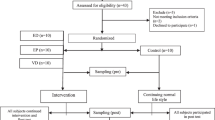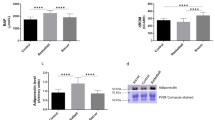Abstract
Objective:
To investigate PON 1/Aryl activities in basketball players with or without α-T supplementation pre- and post-training. Vitamin E (α-tocopherol, α-T) reduces lipid peroxidation. Paraoxonase 1/arylesterase (PON 1/Aryl) activities are closely related to oxidation and atherogenesis.
Subject/Methods:
Blood was obtained from 10 players pre- (group A), post-exercise (group B) and after 1 month on α-T (200 mg per 24 h orally) supplementation pre- (group C) and post-exercise (group D). Lactate, pyruvate, muscle enzyme activities, creatine kinase, lactate dehydrogenase and total antioxidant status (TAS) were measured with commercial kits. Catecholamines and α-T were determined with high-performance liquid chromatography methods and PON 1/Aryl activities spectrophotometrically.
Results:
Lactate, pyruvate, muscle enzyme activities and catecholamines were increased (P<0.001) in all groups post-training. Alpha-T levels remained unaltered pre- vs post-exercise. TAS was decreased in all the groups post training. PON 1/Aryl activities were significantly decreased post-exercise (group B) (PON1: 65±12 U min−1 ml−1, Aryl: 58±14 KU min−1 ml−1) as compared to those pre-exercise (group A) (PON1: 142±16 U min−1 ml−1, Aryl: 114±12 KU min−1 ml−1, P<0.001). In contrast, the studied enzyme activities remained practically unaltered after α-T supplementation pre- vs post-training. Both enzyme activities positively correlated to TAS (r=0.60, P<0.001).
Conclusions:
Alpha-T supplementation may result in protection of the enzyme PON 1/Aryl activities from free radical production.
This is a preview of subscription content, access via your institution
Access options
Subscribe to this journal
Receive 12 print issues and online access
$259.00 per year
only $21.58 per issue
Buy this article
- Purchase on Springer Link
- Instant access to full article PDF
Prices may be subject to local taxes which are calculated during checkout
Similar content being viewed by others
References
Alessio HM, Hagerman AE, Fulkerson BK, Ambrose J, Rice RE, Wiley RL (2000). Generation of reactive oxygen species after exhaustive aerobic and isometric exercise. Med Sci Sports Exerc 32, 1576–1581.
Apostolidis N, Nassis GP, Bolatoglou T, Geladas ND (2004). Physiological and technical characteristics of elite young basketball players. J Sports Med Phys Fitness 44, 157–163.
Arnaud J, Fortis I, Blachier S, Kia D, Favier A (1991). Simultaneous determination of retinol, alpha-tocopherol and beta-carotene in serum by isocratic high-performance liquid chromatography. J Chromatogr 572, 103–116.
Ascherio A, Rimm EB, Hernan MA, Giovannucci E, Kawachi I, Stampfer MJ et al. (1999). Relation of consumption of vitamin E, vitamin C, and carotenoids to risk for stroke among men in the United States. Ann Intern Med 130, 963–970.
Aviram M, Billecke S, Sorenson R, Bisgaier C, Newton R, Rosenblat M et al. (1998). Paraoxonase active site required for protection against LDL oxidation involves its free sulfhydryl group and is different from that required for its arylesterase/paraoxonase activities: selective action of human paraoxonase allozymes Q and R. Arterioscler Thromb Vasc Biol 18, 1617–1624.
Aviram M, Dornfeld L, Rosenblat M, Volkova N, Kaplan M, Coleman R et al. (2000a). Pomegranate juice consumption reduces oxidative stress, atherogenic modifications to LDL, and platelet aggregation: studies in human and in atherosclerotic apolipoprotein E-deficient mice. Am J Clin Nutr 71, 1062–1076.
Aviram M, Hardak E, Vaya J, Mahmood S, Milo S, Hoffman A et al. (2000b). Human serum paraoxonases (PON1) Q and R selectively decrease lipid peroxides in human coronary and carotid atherosclerotic lesions: PON1 esterase and peroxidase-like activities. Circulation 101, 2510–2517.
Aviram M, Rosenblat M, Billecke S, Erogul J, Sorenson R, Bisgaier CL et al. (1999). Human serum paraoxonase (PON 1) is inactivated by oxidized low density lipoprotein and preserved by antioxidants. Free Radic Biol Med 26, 892–904.
Azen S, Qian A, Mack W, Sevanian A, Selzer R, Liu C et al. (1996). Effect of supplementary antioxidant vitamin intake on carotid arterial wall intima-media thickness in a controlled trial of cholesterol lowering. Circulation 94, 2369–2372.
Balakrishnan SD, Anuradha CV (1996). Exercise depletion of antioxidants and antioxidant manipulation. Cell Biochem Funct 16, 269–275.
Berliner J, Heinecke JW (1996). The role of oxidized lipoproteins in atherogenesis. Free Radic Biol Med 20, 707–727.
Candito M, Albertini M, Politano S, Deville A, Mariani R, Chambon P (1993). Plasma catecholamine levels in children. J Chromatogr 617, 304–307.
Chalrton-Menys V, Liu Y, Durrington PN (2006). Semiautomated method for determination of serum paraoxonase activity using paraoxon as substrate. Clin Chem 52, 453–457.
Cooper CE, Vollaard NB, Choueiri T, Wilson MT (2002). Exercise, free radicals and oxidative stress. Biochem Soc Trans 30, 280–285.
Costa LG, Vitalone A, Cole TB, Furlong CE (2001). Modulation of paraoxonase (PON1) activity. Biochem Pharmacol 69, 541–550.
Cunha GM, Moraes RA, Moraes GA, Franka Jr MC, Moraes MO, Viana GS (1999). Nerve growth factor, ganglioside and vitamin E reverse glutamate cytotoxicity in hippocampal cells. Eur J Pharmacol 367, 107–112.
Ferre N, Camps J, Cabre M, Paul A, Joven J (2001). Hepatic paraoxonase activity alterations and free radical production in rats with experimental cirrhosis. Metabolism 50, 997–1000.
Ferre N, Camps J, Fernandez-Ballart J, Arija V, Murphy MM, Ceruelo S et al. (2003). Regulation of serum paraoxonase activity by genetic, nutritional, and lifestyle factors in the general population. Clin Chem 49, 1491–1497.
Finkel T, Holbrook NJ (2000). Oxidants, oxidative stress and the biology of ageing. Nature 408, 239–247.
Harats D, Ben-Naim M, Dabach Y, Hollander G, Havivi E, Stein O et al. (1990). Effect of vitamin C and E supplementation on susceptibility of plasma lipoproteins to peroxidation induced by acute smoking. Atherosclerosis 85, 47–54.
Horwitt MK (2001). Critique of the requirement for vitamin E. Am J Clin Nutr 73, 1003–1005.
Jain SK, Mc Vie R, Smith T (2000). Vitamin E supplementation restores glutathione and malondialdehyde to normal concentrations in erythrocytes of type 1 diabetic children. Diabetes Care 23, 1389–1394.
Jarvik GP, Tsai NT, Mc Kinstry LA, Wani R, Brophy VH, Richter RJ et al. (2002). Vitamin C and E intake is associated with increased Paraoxonase activity. Arterioscler Thromb Vasc Biol 22, 1329–1333.
Jeon SM, Park YB, Kwon OS, Huh TL, Lee WH, Do KM et al. (2005). Vitamin E supplementation alters HDL-cholesterol concentration and paraoxonase activity in rabbits fed high-cholesterol diet: comparison with probucol. J Biochem Mol Toxicol 19, 336–346.
Josse D, Lockridge O, Xie W, Bartels CF, Schopfer LM, Masson P (2001). The active site of human paraoxonase (PON1). J Appl Toxicol 21 (Suppl 1), S7–S11.
Karikas GA, Schulpis KH, Tsakiris S, Tjamouranis J, Georgala S (1999). In vitro effect of galactose-1-phoshate on acetylcholinesterase activity. Res Comm Biol Psychol Psychiatr 24, 55–58.
La Du BN (1996). Structural and functional diversity of paraoxonases. Nat Med 2, 1186–1187.
Lipid Research Clinics Program (1974). Lipid and lipoprotein analysis. In: Manual of Laboratory Operations, vol. 1. National Institutes of Health; Department of Health, Education, and Welfare publication: Bethesda, MD, pp 75–628.
Lohman TG, Roche AF, Martorell R (1988). Anthropometric Standardization Reference Manual. Human Kinetics Books: Champaign, IL, pp 380–394.
Mackness MI (1994). The human paraoxonase polymorphism and atherosclerosis. In: Mackness MI, Cleric M (eds). Esterases, Lipases and Phospholipases. Plenum Press: New York, pp 65–73.
Mackness MI, Abbott C, Arrol S, Durrington PN (1993). The role of high-density lipoprotein and lipid-soluble antioxidant vitamins in inhibiting low-density lipoprotein oxidation. Biochem J 294, 829–834.
Mackness MI, Mackness B, Durrington PN, Connelly PW, Hegele RA (1996). Paraoxonase: biochemistry, genetics and relationship to plasma lipoproteins. Curr Opin Lipidol 7, 69–76.
Miller NJ, Rice-Evans C, Davies MJ, Gopinathan V, Milner A (1993). A novel method for measuring antioxidant capacity and its application to monitoring the antioxidant status in premature neonates. Clin Sci (Lond) 84, 407–412.
Nguyen DS, Sok DE (2001). Oxidative inactivation of paraoxonase 1, an antioxidant protein and its effect on antioxidant action. Free Radic Res 37, 1319–1330.
Nierenberg DW, Lester DC (1985). Determination of vitamins A and E in serum and plasma using a simplified clarification method and high-performance liquid chromatography. J Chromatogr 345, 275–284.
Packer L (1997). Oxidants, antioxidant nutrients and the athlete. J Sport Sci 15, 353–363.
Reaven PD, Witztum JL (2001). Oxidized low density lipoproteins in atherogenesis: role of dietary modification. Annu Rev Nutr 16, 51–71.
Rokitzki L, Logemann E, Sagredos AN, Murphy M, Wetzel-Roth W, Keul J (1994). Lipid peroxidation and antioxidative vitamins under extreme-endurance stress. Acta Physiol Scand 151, 149–158.
Schroder H, Navarro E, Mora J, Galiano D, Tramullas A (2001). Effects of alpha-tocopherol, beta-carotene and ascorbic acid on oxidative, hormonal and enzymatic exercise stress markers in habitual training activity of professional basketball players. Eur J Nutr 40, 178–184.
Schulpis KH, Karikas GA, Tjamouranis J, Michelakakis H, Tsakiris S (2002). Acetylcholinesterase activity and biogenic amines in phenylketonuria. Clin Chem 48, 1794–1796.
Senti M, Tomas M, Fito M, Weinbrenner T, Covas MI, Sala J et al. (2003). Antioxidant paraoxonase 1 activity in the metabolic syndrome. J Clin Endocrinol Metab 88, 5422–5426.
Singh U, Jialal I (2004). Anti-inflammatory effects of alpha-tocopherol. Ann N Y Acad Sci 1031, 195–203.
Tomas M, Elosua R, Senti M, Molina L, Vila J, Anglada R et al. (2002). Paraoxonase 1–192 polymorphism modulates the effects of regular and acute exercise on paraoxonase 1 activity. J Lipid Res 43, 713–720.
Tsakiris S, Michelakakis H, Schulpis KH (2005). Erythrocyte membrane acetylcholinesterase, Na+, K+-ATPase and Mg2+-ATPase activities in patients with classical galactosaemia. Acta Paediatr 94, 1223–1226.
Tsakiris S, Parthimos T, Tsakiris T, Parthimos N, Schulpis KH (2006). Alpha-tocopherol supplementation reduces the elevated 8-hydroxy-2-deoxyguanosine blood levels induced by training in basketball players. Clin Chem Lab Med 44, 1004–1008.
Tsakiris S, Schulpis KH (2000). The effect of galactose metabolic disorders on rat brain acetylcholinesterase activity. Z Naturforsch [C] 55, 852–855.
Vlachos GD, Bartzeliotou A, Schulpis KH, Partsinevelos GA, Lazaropouloulou C, Papadima C et al. (2006). Maternal-neonatal paraoxonase 1 activity in relation to the mode of delivery. Clin Biochem 39, 923–928.
Watson AD, Berliner JA, Hama SY, La Du BN, Fuall KF, Fogelman AM et al. (1995). Protective effect of high density lipoprotein associated paraoxonase: inhibition of the biological activity of minimally oxidized low density lipoprotein. J Clin Invest 96, 2882–2891.
Yaki K (1999). Lipid peroxides and related radicals in clinical medicine. In: Armistrong D (ed). Free Radicals in Diagnostic Medicine. Plenum Press: New York, pp 1–14.
Acknowledgements
This work was funded by the University of Athens and the Institute of Child Health. We thank Mrs Kalliopi Tassopoulou for the careful typing of this paper and the medical students Zois Mellios and Alexios Mentis for their significant assistance.
Author information
Authors and Affiliations
Corresponding author
Rights and permissions
About this article
Cite this article
Tsakiris, S., Karikas, G., Parthimos, T. et al. Alpha-tocopherol supplementation prevents the exercise-induced reduction of serum paraoxonase 1/arylesterase activities in healthy individuals. Eur J Clin Nutr 63, 215–221 (2009). https://doi.org/10.1038/sj.ejcn.1602918
Received:
Revised:
Accepted:
Published:
Issue Date:
DOI: https://doi.org/10.1038/sj.ejcn.1602918
Keywords
This article is cited by
-
Paraoxonases: metabolic role and pharmacological projection
Naunyn-Schmiedeberg's Archives of Pharmacology (2018)
-
Antioxidant treatment strategies for hyperphenylalaninemia
Metabolic Brain Disease (2013)
-
Biomarkers of oxidative stress, antioxidant defence and inflammation are altered in the senescence-accelerated mouse prone 8
AGE (2013)



